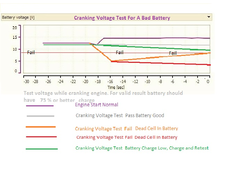
Guide to Simple Battery Cranking Volts Test
britishtrident - 1/5/16 at 09:03 PM
This high load test can diagnose a bad cell in a battery it requires only a voltmeter and uses the cranking current of the starter motor as a dummy
load.
A dead cell is shorted out and is sometimes called a gassing cell.
Before testing the battery should have at least 75% charge. ideally it should be rested off charge for a few hours.
Batteries that have been charged and not used have a surface charge that must be removed before testing to avoid skewing the results. To remove the
surface charge switch the side lights on for about 10 minutes before the test, switch them off before the test.
To prevent the engine starting while carring out the test you must disconnect either the ignition or the injectors --- on injection engines
disconnecting the injectors prevents bore washing.
Then simply crank the engine for about 20 seconds using the starter observing the battery voltage and compare the results to the attached graph.
A good battery will not drop below 9.5 volts. a battery with a dead cell will drop very rapidly to below 7 volts.


Battery Cranking Voltage Test
[Edited on 1/5/16 by britishtrident]
gremlin1234 - 1/5/16 at 09:29 PM
I guess this only applies to lead acid batteries
Bluemoon - 2/5/16 at 05:34 AM
yes..
britishtrident - 2/5/16 at 11:03 AM
The answer is both yes and no, a load test is valid way to test any type of battery. This test only puts the batteries normal maximum current on for
20 seconds so will not damage the battery. The problem is that results are not as clear cut on other battery types and some types of battery often
give little or no warning before complete failure -- I have seen a few Varley green tops fail with a puff of smoke.
However if the cranking voltage drops below about 9.5 volts on a fully charged 12v battery you should investigate .
If a car has a modern voltmeter that reacts quickly (ie not one of the old 1970's Smiths Bi-metal type) it is a good ideal to keep an eye on the
dip voltage when starting the engine and also how fast the voltage drops off after the engine is stopped.
[Edited on 2/5/16 by britishtrident]


